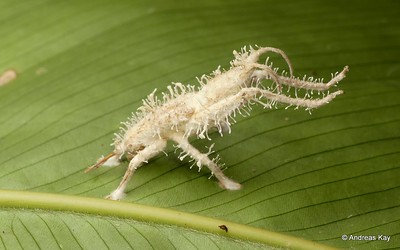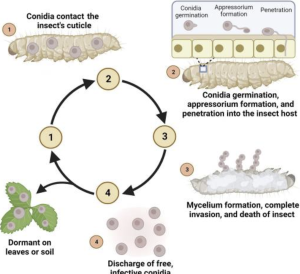Entomopathogenic fungi

Entomopathogenic Fungi are parasitic microorganisms that infect insect hosts in many different ecosystems. They serve as a means to control insect populations and in doing so, prevents the overgrowth of insect organisms in soil environments and enhance biodiversity. When infected, the insects eventually die off promoting the growth of soil microorganisms. They are then an energy source for microorganisms and contribute to nutrient cycling and promote plant growth. Entomopathogenic Fungi can be referred to as "EPF" and are responsible for over 60% of insect deaths in nature. [3]

Life Cycle
The fungi cycle begins with dormant fungi present on leaf, leaf litter, or soil ground. When an insect makes contact with this fungus, it attaches to the host organism's cuticle, or outside layer, preparing itself for penetration of the host. The next step involves germination of the conidia (asexual, non-motile spores) and the formation of the appressorium, which is almost like a peg produced by the conidia that can pierce the outer layer of the host organism. Once inside, step 3 begins and the hyphae begin to develop inside the host. Cell numbers rapidly multiply within the hemocoel (internal 'blood' and organs of the insect) until the hyphae grow enough to kill the organism. The final stage is fungal sporulation. Once the spores are developed, they get dispersed from the host organism. Some say this process could be more specific, spliting 4 steps into 6 steps, but the process remains the same.
Soil Benefits
EPF has been used as a means to control pest and insect populations for generations due to its biopesticidal properties. There are 1600 known species across 90 genera but the primary products produced from EPF derive from a much smaller selection, at least 12 species, since they are easier to mass produce and they are more efficient. The most widely commercially produced fungi come from species within the Beauveria, Metarhizium, Lecanicillium and Isaria generas. [5] These developments and practices help to introduce a new method of pest and population control in soil environments that avoid the use of highly processed pesticides.
EPF can promote soil aggregation by producing sticky protiens like glomalin and glycoprotien polysaccharides. These substances are also helpful in retaining water, nutrients, and carbon. All of these factors contribute to enhanced plant growth. Regarding nutrient recycling, it has been found that EPFs are able to decompose organic matter with a lower metabolic nutrient demand as well as being able to utilize a wider array of enzymes in the process. As a result, EPFs can more effectively decompose "sugars, organic acids, amino acids... cellulose, pectin, lignin, lignocellulose, chitin, starch... hydrocarbons, pesticides, and other xenobiotics" (Murindangabo). [4]
One paper from September 2022 by Liu et al. exposes some of the EPF properties that promote plant growth. After studying how two EPFs, Beauveria bassiana and Metarhizium anisopliae, interact with the growth of corn, it was found that the influence of the fungal endophytic function was actually greater than that of the rhizosphereic functions. The fungi was able to "establish systematic colonization in tissues of all maize organs through maize roots... within 1 week" (Liu et al.). [2] The quick establishment of fungal systems within the corn species can be a new avenue for farmers/agriculture practices to grow food in shorter time frames, with increased quality, and more abundance. As with any new scientific advancement though, much more research is needed to prove the saftey and effectiveness of EPF in plant growth, especially beyond just corn species.
References
[1] Kay, A.,(2017). Cricket? with Entomopathogenic fungus [Photograph]. flickr.com. https://www.flickr.com/photos/andreaskay/44264582075/in/photostream/
[2] Liu, Y., Yang, Y. & Wang, B. Entomopathogenic fungi Beauveria bassiana and Metarhizium anisopliae play roles of maize (Zea mays) growth promoter. Sci Rep 12, 15706 (2022). https://doi.org/10.1038/s41598-022-19899-7
[3] Ma M, Luo J, Li C, Eleftherianos I, Zhang W and Xu L (2024) A life-and-death struggle: interaction of insects with entomopathogenic fungi across various infection stages. Front. Immunol. 14:1329843. doi: 10.3389/fimmu.2023.1329843
[4] Murindangabo, Y. T., Kopecký, M., Perná, K., Konvalina, P., Bohatá, A., Kavková, M., & Nguyen, T. G. (2024). Relevance of entomopathogenic fungi in soil-plant systems. Plant and Soil, 495(1-2), 287+. http://dx.doi.org.gate.lib.buffalo.edu/10.1007/s11104-023-06325-8
[5] Vega, Fernando E., et al. “Fungal Entomopathogens: New Insights on Their Ecology.” Fungal Ecology, vol. 2, no. 4, 2009, pp. 149–59, https://doi.org/10.1016/j.funeco.2009.05.001.
[6] Zhang, W., Chen, X., Eleftherianos, I., Mohamed, A., Bastin, A., & Keyhani, N. O. (2024). Cross-talk between immunity and behavior: insights from entomopathogenic fungi and their insect hosts. FEMS microbiology reviews, 48(1), fuae003. https://doi.org/10.1093/femsre/fuae003